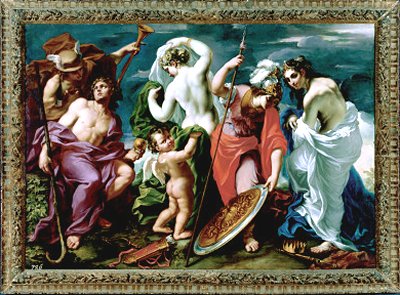 |
|
Presentation
mode for the “Judgment of Paris” painting by Ludivico David,
to reach visitors with different levels of art experience.
By: Willem van Osnabrugge. March 14, 2000
This paper is more of a key point script for my talk, than an
in-depth description of an actual lecture. It describes the main steps, which I would use
in the (verbal) presentation.
Describe painting:
First Round: Very brief description. Two men, three women, a child with wings.
Second round: Analytical only. No interpretation.
more detailed
forms, figures, facial expressions
colors
landscape |
Read title of label and tell story:
Greek gods, Zeus, Thetis, Mother Earth, marry Peleus (mortal), Strife, golden apple,
Hermes, Paris on Mt. Ida guarding sheep flock of his father Prince Priam of Troy. Bribes.
Hera: Goddess of married women offered: Ruler of all Asia.
Athena: Goddess of wisdom and moral wars offered: Wisdom and victory in all battles.
Aphrodite: Goddess of love offered: Helen of Sparta, the most beautiful woman in the
world. Her beauty equaled Aphrodite.
Who is artist and some history:
Painted at ~ 1700 by Luvidico David. Born in Northern Italy. Training in Milan, (Bologna)
and Venice. Had his own schools. When he was 38 he moved to Rome, till he died at >80.
Trouble maker. David was always challenging the art establishment, playing down the
importance of life drawing (and drapery studies) making it secondary to the painter’s
own ideas (the design versus the color debate).
Interpretation:
Paris: still holding apple, agony, eyes, staff
Hermes: round hat + wings (normally on feet), messenger of Zeus, pointing
Aphrodite: smirk on face (how do you paint that from the back?), magic girdle (if the
Victoria Secret or Playtex Company only knew)
Eros, illegitimate son of Ares, smiling, “Hey, what are you looking at?”
Athena: goddess of war, red colors, can’t miss her as an army commander in front.
Shield with head of Medusa (turned people into stone). She had given a (mirror) shield to
Perseus to decapitate Medusa. Painters always made such a shield when portraying Athena.
It was her trademark.
Hera (white armed): Wife of Zeus. Holding her composure. Looks at you and says “Hey,
what are you looking at”. Lower your eyes. I’m a goddess. After event:
“Hell hath no fury like a goddess scorned”
Execution of painting:
The Renaissance style had quiet, balanced compositions. In 1700 Rome is the artistic
capital of Europe. Wealthy patrons. David couples late Roman classicism with the more
sensuous plasticity of the earlier Bolognese artists, while also showing a taste for the
dramatic lighting and chiaroscuro that came from the Milanese tradition. Here David proves
his conviction that the movement, color and drama is more important than perfect drawing.
It is an excellent example of what we now call Baroque art. Some examples: (dramatic,
grandeur, richness, sensuous, drama, movement, tension). Art on steroids.
Suggestion of movement
Expressive use of light
Strong colors
Co-extensive space. Bring viewer in. Two people looking at you
Background not so important
Classical prototypes and mythical experiences. More psychology in paintings. Most
prestigious. More than portrait, still life or genre paintings. Nude figures showed that
they were not of that time
Finally, something called “allegory”. Symbolism. To use one story to tell
another.
The allegory story (the morale): (a bit of light heartedness
to liven up the presentation and let the audience make a personal connection). It is one
of my favorite paintings. It tells you all about life and relationships . It is very
philosophical. Ask your audience: before you go to bed tonight consider this: What would
you do if your god gave you the choice between love, wisdom and power. That is what this
painting is about. The choice between “love”, “wisdom”
and “power”.
But…, Paris had another choice: not to make a
choice. He knew he was in for trouble.
He was already married to a nymph
Helen was already married and had a daughter
Her brother-in-law, was the powerful and proud King of Sparta
Victory in battles might be short lived and modified by other events
He knew that the other gods would take revenge on him
So the morale of the story is: Magic quick fixes look tempting
initially, but are never long lasting. Be happy with what you are and have and build from
there.
|
